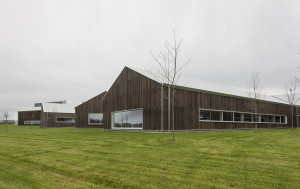Technical and Logistics Center OIKEN+
2020-
Sierre-Switzerland
13.036 m2
Una industria es un lugar de producción pero también, y sobre todo, un lugar de trabajo funcional, donde además de la lógica, que sin duda es muy importante, también debe estar muy presente la derivada de los valores espaciales, de la representación y, principalmente, de comodidad en el trabajo.
Together with the aspects related to efficiency and the most sensible and logical arrangement of the plot and the functional relationships, we intend our proposal to take into account the cultural, symbolic and landscape context of the geographical area in which it is located. A contextual response that has much to do with the territory and the construction of the rural area. Our proposal is inspired by the architecture that we can see in the nearby mountains and landscapes, in a vernacular architecture of powerful roofs that, properly interpreted in contemporary terms, can effectively accommodate the use of storage, distribution service and offices, object of the competition.
The constructive type thus defined, will define a very integrated image and, especially in the office area, will produce the sensation of working in a pleasant and “domestic” environment, in a more friendly and human atmosphere.
The organization of the architectural complex follows a very clear scheme in terms of plot occupation and functionality. It is structured according to a system of parallel bands located approximately in the center of the plot. These structural bands are arranged in an east-west direction. The northernmost band, the longest, houses the office uses and becomes the axis that communicates these uses with the storage uses located and organized in the most efficient way from the geometrical point of view and its location in the plot that makes possible an easy operation in the interior and access for loading and unloading of supply trucks. On the west side, with a broken shape and differentiated in plan, there is another body of offices that will be dedicated to renting. The plan form of this body tries to create a concave space in the center, generating a kind of “square” in the set, a pleasant and landscaped place, representative of the idea of coexistence at work that assumes the company that creates the industrial complex created, where the space dedicated to a cafeteria is located. A central place, equidistant from all the uses of the building, where all the workers of the complex and visitors can gather.
7GGF+HQ Sierre, Suiza
